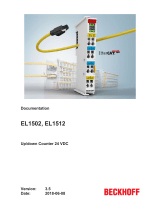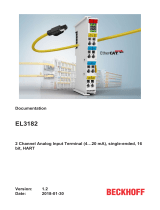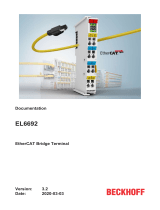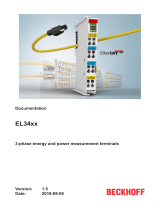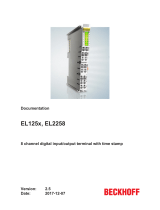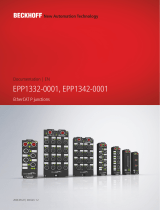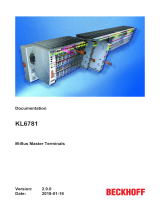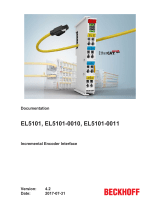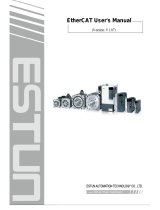
Documentation
EL600x, EL602x
Serial Interface Terminals
4.6
2018-09-24
Version:
Date:


Table of contents
EL600x, EL602x 3Version: 4.6
Table of contents
1 Foreword ....................................................................................................................................................5
1.1 Overview Serial Interface Terminals..................................................................................................5
1.2 Notes on the documentation..............................................................................................................5
1.3 Safety instructions .............................................................................................................................7
1.4 Documentation Issue Status..............................................................................................................8
1.5 Version identification of EtherCAT devices .......................................................................................9
2 Product overview.....................................................................................................................................14
2.1 EL6001, EL6021..............................................................................................................................18
2.1.1 Introduction ...................................................................................................................... 18
2.1.2 Technical data ................................................................................................................. 19
2.2 EL6002, EL6022..............................................................................................................................20
2.2.1 Introduction ...................................................................................................................... 20
2.2.2 Technical data ................................................................................................................. 21
2.3 Start up ............................................................................................................................................21
3 Basics communication ...........................................................................................................................22
3.1 EtherCAT basics..............................................................................................................................22
3.2 EtherCAT cabling – wire-bound.......................................................................................................22
3.3 General notes for setting the watchdog...........................................................................................23
3.4 EtherCAT State Machine.................................................................................................................25
3.5 CoE Interface...................................................................................................................................27
3.6 Distributed Clock .............................................................................................................................32
4 Mounting and Wiring...............................................................................................................................33
4.1 Instructions for ESD protection........................................................................................................33
4.2 EL6001, EL6021..............................................................................................................................33
4.2.1 Installation on mounting rails ........................................................................................... 33
4.2.2 Connection....................................................................................................................... 36
4.2.3 Positioning of passive Terminals ..................................................................................... 40
4.2.4 LEDs and terminal connector assignments ..................................................................... 41
4.3 EL6002, EL6022..............................................................................................................................43
4.3.1 Mounting and demounting - terminals with front unlocking.............................................. 43
4.3.2 Recommended mounting rails ......................................................................................... 45
4.3.3 LEDs and pin assignment................................................................................................ 46
4.4 Positioning of passive Terminals .....................................................................................................49
4.5 Installation instructions for enhanced mechanical load capacity .....................................................50
4.6 Installation positions ........................................................................................................................51
4.7 UL notice .........................................................................................................................................53
4.8 ATEX - Special conditions (extended temperature range) ..............................................................54
4.9 ATEX Documentation ......................................................................................................................55
5 Commissioning........................................................................................................................................56
5.1 TwinCAT Quick Start .......................................................................................................................56
5.1.1 TwinCAT2 ....................................................................................................................... 58
5.1.2 TwinCAT 3 ....................................................................................................................... 68
5.2 TwinCAT Development Environment ..............................................................................................80

Table of contents
EL600x, EL602x4 Version: 4.6
5.2.1 Installation of the TwinCAT real-time driver..................................................................... 80
5.2.2 Notes regarding ESI device description........................................................................... 86
5.2.3 TwinCAT ESI Updater ..................................................................................................... 90
5.2.4 Distinction between Online and Offline............................................................................ 90
5.2.5 OFFLINE configuration creation ...................................................................................... 91
5.2.6 ONLINE configuration creation ........................................................................................ 96
5.2.7 EtherCAT subscriber configuration................................................................................ 104
5.3 General Notes - EtherCAT Slave Application................................................................................114
5.4 Operating modes and process data ..............................................................................................122
5.5 Hints regarding TcVirtualComDriver..............................................................................................129
5.6 Communication features................................................................................................................131
5.7 LIN Master Feature EL6001 ..........................................................................................................132
5.8 Example programs ........................................................................................................................136
5.8.1 Sample program 1 ......................................................................................................... 136
5.8.2 Sample program 2 ......................................................................................................... 139
5.8.3 Sample program 3 (LIN) ................................................................................................ 141
6 Overview of CoE objects EL6001, EL6021 ..........................................................................................144
6.1 Object description and parameterization .......................................................................................144
6.1.1 Objects for commissioning............................................................................................. 144
6.1.2 Standard objects (0x1000-0x1FFF) ............................................................................... 146
6.1.3 Profile-specific objects (0x6000-0xFFFF) [from hardware version 03] .......................... 162
6.2 Control and status word.................................................................................................................165
7 Overview CoE objects EL6002, EL6022...............................................................................................168
7.1 Object description and parameterization .......................................................................................168
7.1.1 Objects for commissioning............................................................................................. 168
7.1.2 Standard objects (0x1000-0x1FFF) ............................................................................... 169
7.1.3 Profile-specific objects (0x6000-0xFFFF) [from hardware version 03] .......................... 181
7.2 Control and status data .................................................................................................................184
8 Appendix ................................................................................................................................................186
8.1 EtherCAT AL Status Codes...........................................................................................................186
8.2 Firmware compatibility...................................................................................................................186
8.3 Firmware Update EL/ES/EM/EPxxxx ............................................................................................187
8.3.1 Device description ESI file/XML..................................................................................... 188
8.3.2 Firmware explanation .................................................................................................... 191
8.3.3 Updating controller firmware *.efw................................................................................. 192
8.3.4 FPGA firmware *.rbf....................................................................................................... 193
8.3.5 Simultaneous updating of several EtherCAT devices.................................................... 197
8.4 Restoring the delivery state ...........................................................................................................198
8.5 Support and Service ......................................................................................................................199

Foreword
EL600x, EL602x 5Version: 4.6
1 Foreword
1.1 Overview Serial Interface Terminals
EL6001 [}18] (1 channel Serial Interface Terminal, RS232C)
EL6021 [}18] (1 channel Serial Interface Terminal, RS422/RS485)
EL6002 [}20] (2 channel Serial Interface Terminal, RS232C)
EL6022 [}20] (2 channel Serial Interface Terminal, RS422/RS485)
1.2 Notes on the documentation
Intended audience
This description is only intended for the use of trained specialists in control and automation engineering who
are familiar with the applicable national standards.
It is essential that the documentation and the following notes and explanations are followed when installing
and commissioning these components.
It is the duty of the technical personnel to use the documentation published at the respective time of each
installation and commissioning.
The responsible staff must ensure that the application or use of the products described satisfy all the
requirements for safety, including all the relevant laws, regulations, guidelines and standards.
Disclaimer
The documentation has been prepared with care. The products described are, however, constantly under
development.
We reserve the right to revise and change the documentation at any time and without prior announcement.
No claims for the modification of products that have already been supplied may be made on the basis of the
data, diagrams and descriptions in this documentation.
Trademarks
Beckhoff
®
, TwinCAT
®
, EtherCAT
®
, EtherCATP
®
, SafetyoverEtherCAT
®
, TwinSAFE
®
, XFC
®
and XTS
®
are
registered trademarks of and licensed by Beckhoff Automation GmbH.
Other designations used in this publication may be trademarks whose use by third parties for their own
purposes could violate the rights of the owners.
Patent Pending
The EtherCAT Technology is covered, including but not limited to the following patent applications and
patents: EP1590927, EP1789857, DE102004044764, DE102007017835 with corresponding applications or
registrations in various other countries.
The TwinCAT Technology is covered, including but not limited to the following patent applications and
patents: EP0851348, US6167425 with corresponding applications or registrations in various other countries.
EtherCAT
®
is registered trademark and patented technology, licensed by Beckhoff Automation GmbH,
Germany

Foreword
EL600x, EL602x6 Version: 4.6
Copyright
© Beckhoff Automation GmbH & Co. KG, Germany.
The reproduction, distribution and utilization of this document as well as the communication of its contents to
others without express authorization are prohibited.
Offenders will be held liable for the payment of damages. All rights reserved in the event of the grant of a
patent, utility model or design.

Foreword
EL600x, EL602x 7Version: 4.6
1.3 Safety instructions
Safety regulations
Please note the following safety instructions and explanations!
Product-specific safety instructions can be found on following pages or in the areas mounting, wiring,
commissioning etc.
Exclusion of liability
All the components are supplied in particular hardware and software configurations appropriate for the
application. Modifications to hardware or software configurations other than those described in the
documentation are not permitted, and nullify the liability of Beckhoff Automation GmbH & Co. KG.
Personnel qualification
This description is only intended for trained specialists in control, automation and drive engineering who are
familiar with the applicable national standards.
Description of instructions
In this documentation the following instructions are used.
These instructions must be read carefully and followed without fail!
DANGER
Serious risk of injury!
Failure to follow this safety instruction directly endangers the life and health of persons.
WARNING
Risk of injury!
Failure to follow this safety instruction endangers the life and health of persons.
CAUTION
Personal injuries!
Failure to follow this safety instruction can lead to injuries to persons.
NOTE
Damage to environment/equipment or data loss
Failure to follow this instruction can lead to environmental damage, equipment damage or data loss.
Tip or pointer
This symbol indicates information that contributes to better understanding.

Foreword
EL600x, EL602x8 Version: 4.6
1.4 Documentation Issue Status
Version Comment
4.6 • Correction RS232 level
• Update chapter "Technical data"
• Update structure
• Update revision status
4.5 • Update chapter "Commissioning"
• Update revision status
4.4 • Update chapter "Technical data"
• Update chapter "Operating modes and process data"
• Update chapter " Communication features"
• Update structure
• Update revision status
4.3 • Update chapter "Technical data"
• Addenda chapter "Instructions for ESD protection"
• Chapter "ATEX - Special conditions" replaced with chapter "ATEX - Special conditions (extended temperature
range)"
• Addenda chapter "TwinCAT Quickstart"
• Update revision status
4.2 • Update in section ”LEDs and terminal connector assignments”
4.1 • Addenda in section “LEDs and pin assignment”
4.0 • Migration and revision
• Section "Mounting and demounting" in section "EL6002, EL6022" in "Mounting and wiring" complemented with
"Front unlocking"
• Section "Installation instructions for enhanced mechanical load capacity" moved from subsection "EL6001,
EL6021" to section "Mounting and wiring"
• Section "Installation positions" removed from subsection "EL6001, EL6021" (since already present in higher-level
section)
• Section "Configuration with the TwinCAT System Manager" moved from section "Commissioning" to subsection
"TwinCAT 2.1x"
• Section "LIN Feature EL6001" moved to section "Commissioning"
• Sections "Sample program 1" and "Sample program 2" consolidated into new section "Sample programs"; new
section "Sample programs" integrated in section "Commissioning“
• Section "Sample program 3 (LIN)" added to section "Sample programs"
3.8 • "Technical data" section updated
• "Installation instructions for enhanced mechanical load capacity" section supplemented
• Structural update
• Revision version updated
3.7 • Update LED description
• Update revision status
3.6 • Update revision status
• Update structure
3.5 • Update chapter "Technical data"
• Update chapter "Object description and parameterization"
• Update chapter "Communication features"
• Update chapter "Technology"
• Update chapter "Process data"
• Update structure

Foreword
EL600x, EL602x 9Version: 4.6
Version Comment
3.4 • Update chapter "Technology"
3.3 • Update Technical data
3.2 • Update Technical data
3.1 • Addenda of notes and description of command mode
3.0 • Update chapter "Object description"
2.9 • Addenda chapter "Communication features and TcVirtualComDriver"
2.8 • Update Technical data
2.7 • Update Technical data
2.6 • Update chapter "Technology" and "Process data"
2.5 • Update chapter "Technology"
2.4 • Object description and Technical notes added
2.3 • Firmware compatibility notice, Technical notes added
2.2 • Addenda
2.1 • Addenda
2.0 • First public issue
0.3 • Addenda
0.2 • Corrections and addenda
0.1 • Preliminary documentation for EL60xx
1.5 Version identification of EtherCAT devices
Designation
A Beckhoff EtherCAT device has a 14-digit designation, made up of
• family key
• type
• version
• revision
Example Family Type Version Revision
EL3314-0000-0016 EL terminal
(12 mm, non-
pluggable connection
level)
3314 (4-channel thermocouple
terminal)
0000 (basic type) 0016
ES3602-0010-0017 ES terminal
(12 mm, pluggable
connection level)
3602 (2-channel voltage
measurement)
0010 (high-
precision version)
0017
CU2008-0000-0000 CU device 2008 (8-port fast ethernet switch) 0000 (basic type) 0000
Notes
• The elements mentioned above result in the technical designation. EL3314-0000-0016 is used in the
example below.
• EL3314-0000 is the order identifier, in the case of “-0000” usually abbreviated to EL3314. “-0016” is the
EtherCAT revision.
• The order identifier is made up of
- family key (EL, EP, CU, ES, KL, CX, etc.)
- type (3314)
- version (-0000)
• The revision -0016 shows the technical progress, such as the extension of features with regard to the
EtherCAT communication, and is managed by Beckhoff.
In principle, a device with a higher revision can replace a device with a lower revision, unless specified
otherwise, e.g. in the documentation.
Associated and synonymous with each revision there is usually a description (ESI, EtherCAT Slave

Foreword
EL600x, EL602x10 Version: 4.6
Information) in the form of an XML file, which is available for download from the Beckhoff web site.
From 2014/01 the revision is shown on the outside of the IP20 terminals, see Fig. “EL5021 EL terminal,
standard IP20 IO device with batch number and revision ID (since 2014/01)”.
• The type, version and revision are read as decimal numbers, even if they are technically saved in
hexadecimal.
Identification number
Beckhoff EtherCAT devices from the different lines have different kinds of identification numbers:
Production lot/batch number/serial number/date code/D number
The serial number for Beckhoff IO devices is usually the 8-digit number printed on the device or on a sticker.
The serial number indicates the configuration in delivery state and therefore refers to a whole production
batch, without distinguishing the individual modules of a batch.
Structure of the serial number: KKYYFFHH
KK - week of production (CW, calendar week)
YY - year of production
FF - firmware version
HH - hardware version
Example with
Ser. no.: 12063A02: 12 - production week 12 06 - production year 2006 3A - firmware version 3A 02 -
hardware version 02
Exceptions can occur in the IP67 area, where the following syntax can be used (see respective device
documentation):
Syntax: D ww yy x y z u
D - prefix designation
ww - calendar week
yy - year
x - firmware version of the bus PCB
y - hardware version of the bus PCB
z - firmware version of the I/O PCB
u - hardware version of the I/O PCB
Example: D.22081501 calendar week 22 of the year 2008 firmware version of bus PCB: 1 hardware version
of bus PCB: 5 firmware version of I/O PCB: 0 (no firmware necessary for this PCB) hardware version of I/O
PCB: 1
Unique serial number/ID, ID number
In addition, in some series each individual module has its own unique serial number.
See also the further documentation in the area
• IP67: EtherCAT Box
• Safety: TwinSafe
• Terminals with factory calibration certificate and other measuring terminals

Foreword
EL600x, EL602x 11Version: 4.6
Examples of markings
Fig.1: EL5021 EL terminal, standard IP20 IO device with serial/ batch number and revision ID (since
2014/01)
Fig.2: EK1100 EtherCAT coupler, standard IP20 IO device with serial/ batch number
Fig.3: CU2016 switch with serial/ batch number

Foreword
EL600x, EL602x12 Version: 4.6
Fig.4: EL3202-0020 with serial/ batch number 26131006 and unique ID-number 204418
Fig.5: EP1258-00001 IP67 EtherCAT Box with batch number/ date code 22090101 and unique serial
number 158102
Fig.6: EP1908-0002 IP67 EtherCAT Safety Box with batch number/ date code 071201FF and unique serial
number 00346070
Fig.7: EL2904 IP20 safety terminal with batch number/ date code 50110302 and unique serial number
00331701

Foreword
EL600x, EL602x 13Version: 4.6
Fig.8: ELM3604-0002 terminal with unique ID number (QR code) 100001051 and serial/ batch number
44160201

Product overview
EL600x, EL602x14 Version: 4.6
2 Product overview
Technology
The EL600x and EL602x serial interface terminals enable the connection of devices with an RS232 (or
RS485 / RS422) interface. In the case of the EL600x, the data is exchanged with the controller in full duplex
mode; in the case of the EL602x, half duplex mode is additionally possible. The terminal has one receive
buffer an one transmit buffer per channel, see technical data. Data transfer between the terminal and the
controller takes place via a handshake.
The factory setting of the terminals is:
• 9600 baud
• 8N1: 8 data bits, 1 stop bit, no parity
• in the EL600x the RTS/CTS control is active
• the EL602x operates in full duplex mode with deactivated point-to-point connection.
Basic principles
During transfer of several bytes of data, the data (x bytes or 8*x bits in total) are sent in individual telegrams
containing 7 or 8 bits, based on the coding specification (e.g. 7E2 or 8N1). A telegram consists of:
• Start bit
• Data bits (7 or 8, starting with the LSB [least significant bit])
• Optional: parity bit
◦ "E" EVEN: The parity bit is set by the sender such that the parity is even
◦ "O" ODD: The parity bit is set by the sender such that the parity is odd
◦ "N" NOT: no parity bit
◦ "M" MARK: The parity bit is set to 1 by the sender
◦ "S" SPACE: The parity bit is set to 0 by the sender
• Stop bit (1 or 2)
Accordingly, the coding specification 8N1 means: 8 data bits, no parity bit, 1 stop bit.
If 7-bit coding is selected, of each data byte that is transferred from the PLC to the terminal via the cyclic
process data, only the lower 7 bits are sent. In other words, if 10 bytes of data (consisting of 8 bits) are sent
to the EL60xx, 10 telegrams of 7 bits each are sent.
If 9-bit coding is selected, the 16-bit process data interface must be used. The terminal then expects the 9
useful bits in the lower 9 bits of the 16-bit word.
Frequency
The frequency of the data transfer must be known in the sender and receiver and match within a few
percent, in order to ensure that the receiver can correctly detect any changes in level on the line.
Handshake
An additional handshake between the sender and the receiver can be used so that the receiver can indicate
that it is ready to receive. The EL60xx supports two types of handshake:
• via special RTS/CTS data cables
◦ This features must be activated in the CoE.
◦ Only possible with EL6001/EL6002.
• via special data telegrams
◦ This features must be activated in the CoE.

Product overview
EL600x, EL602x 15Version: 4.6
Level interfaces
The EL6001/6002 devices operate at an RS232 level with reference to GND, the EL6021/6022 devices with
a differential RS485/422 level.
Fig.9: Level interfaces RS232, RS485/422
Termination and topology
The serial RS422 and RS485 communication technologies operate with voltage levels on a 2-wire line.
Reflections at high-resistance line ends can lead to signal distortion. For this reason termination resistors are
required at the receiver. For RS422/485 these are 120Ω resistors, which together with the line resistance
result in a voltage drop over the transmission link.
Permitted cable length
The line resistance together with the termination resistor results in an overall voltage drop over the
transmission link. An unacceptably high number of termination resistors would result in excessive
attenuation of the signal.
The system design should ensure that the voltage does not drop below 200mV at the receiver (see
Fig. ), which is the minimum voltage required.
In RS422 mode each line must be terminated with 120Ω at the receiver.
Fig.10: RS422 termination
In RS485 mode with several devices, termination resistors are only used at the two end devices.

Product overview
EL600x, EL602x16 Version: 4.6
Fig.11: RS485 termination
The background is the different design of RS422/EIA-422 and RS485/EIA-485:
• RS422: 1 Rx → Tx n (maximum 10 receivers)
• RS485: n Rx → Tx m (maximum 32/128 devices, depending on the resulting bus loading)
Components for RS485 usually have a higher input impedance, resulting in lower bus load.
Termination with EL602x and BIAS resistors
The EL602x devices do not have integrated termination resistors, in order to enable operation in
bus mode. Any termination that may be required must be connected outside the terminal.
The EL602x devices feature integrated bias resistors < 1 kOhm, which bring the bus lines to defined
levels, even if the line is disconnected.
If several EL602x devices are connected in a bus, the parallel bias resistors may hamper the data
communication. In this case the EL6021-0021, which has significantly higher bias resistors, should
be used as an intermediate device.
Topology
The termination and the bias resistors generate a load on the bus. However, they are essential for
unambiguous bus levels and therefore have to be positioned with diligence. Ideally the RS422/485 bus
should be configured as a daisy chain or a simple chain, see Fig. [}17] The following topologies may be
problematic:
• Star topologies: each end point should ideally be terminated, but this can lead to excessive bus loading
and ambiguous signal levels. Other potential issues are reflections and runtime variations.
• Intermeshed topologies: no clear end points, which means reflections and circulating currents are
possible.
Shielding/shield
NOTE
Do not use functional earth for discharge of residual currents or potential differences!
The EL60xx units offer a shielded connection for discharging EMC interference via the cable shield (FE,
functional earth). The shield must not be misused for discharging residual currents or potential differences.
The EL60xx units offer a shielded connection for discharging EMC interference via the cable shield (FE,
functional earth). The shield must not be misused for discharging residual currents or potential differences.

Product overview
EL600x, EL602x 17Version: 4.6
Fig.12: EL60xx shield connection
In the 2-channel versions the D-Sub 9 shield is connected with the mounting rail via a high-resistance RC
combination.

Product overview
EL600x, EL602x18 Version: 4.6
2.1 EL6001, EL6021
2.1.1 Introduction
Serial Interface Terminal (RS232C/RS422/RS485), 1 channel
The EL6001 and EL6021 serial interfaces enable the connection of devices with RS-232 or RS422/RS485
interface. The EL6001 operates in conformity with the CCITT V.28/DIN 66 259-1 standards.
The device connected to the EL6001 EtherCAT Terminal communicates with the automation device via the
coupler. The active communication channel operates independently of the higher-level bus system in full
duplex mode or selectable half duplex mode (EL6021) at up to 115.2kbaud.
The RS232 interface guarantees high immunity to interference through electrically isolated signals, which is
additionally guaranteed for the EL6021 through differential signal transmission.
In conjunction with the TwinCAT Virtual Serial COM Driver (see TwinCAT Supplements – Communication)
the EL6001/EL6021 can be used as a normal Windows COM interface.
Quick links
• EtherCAT basics [}22]
• Technology Serial Interface Terminals [}14]
• Commissioning [}56]
• Process data, general notes [}122]
• CoE object description and parameterization EL60x1 [}144]
• Control and status data EL60x1 [}165]

Product overview
EL600x, EL602x 19Version: 4.6
2.1.2 Technical data
Technical data EL6001 EL6021
Data transfer channels TxD and RxD, full duplex TxD and RxD, full/half duplex
Data transfer rate 2400...115200baud,
default: 9600baud, 8data bits,
no parity, 1 stop bit
from firmware 07 [}186]:
also 12000baud and
14400baud
from firmware 11 [}186]:
any integer baud rate 1000…
115200Baud
2400...115200baud,
default: 9600baud, 8data bits,
no parity, 1stop bit
Data buffer 864byte receive buffer, 128byte transmit buffer
EL6001 from FW08: 250byte transmit buffer
Bit transfer - with differential signal
Level interface RS232 RS485/422
Bit distortion < 3 % -
Cable length max. 15m max. 1000m (Twisted Pair)
Line impedance - 120Ω
Providing external supply - -
Diagnosis Status LEDs
Power supply via the E-Bus
Current consumption via E-bus typ. 120mA typ. 170mA
(in case of short circuit: typ.
250mA)
Electrical isolation 500 V
(E-bus/RS232C)
500 V
(E-bus/RS422, E-bus/RS485)
Bit width in process image 1 x 8bit Control/Status, Inputs/Outputs: 3 x 8bit user data or
1 x 8bit Control/Status, Inputs/Outputs: 5 x 8bit user data or
1 x 16bit Control/Status, Inputs/Outputs: 22 x 8bit user data
(configurable)
Configuration no address setting required
configuration via TwinCAT System Manager
Weight approx. 55g
Permissible ambient temperature range
during operation
-25°C ... +60°C (extended temperature range)
Permissible ambient temperature range
during storage
-40°C ... +85°C
Permissible relative humidity 95%, no condensation
Dimensions (W x H x D) approx. 15mm x 100mm x 70mm (width aligned: 12mm)
Mounting on 35mm mounting rail conforms to EN 60715
Vibration/shock resistance conforms to EN 60068-2-6 / EN 60068-2-27,
see also installation instructions [}50] for enhanced mechanical
load capacity
EMC immunity/emission conforms to EN 61000-6-2 / EN 61000-6-4
Protection class IP20
Installation position variable
Approval CE
ATEX [}54]
cULus [}53]
CE
ATEX [}54]
cULus [}53]
IECEx

Product overview
EL600x, EL602x20 Version: 4.6
2.2 EL6002, EL6022
2.2.1 Introduction
Serial Interface Terminal (RS232C/RS422/RS485), 2 channel
The EL6002 and EL6022 serial interfaces enable the connection of devices with two RS232 or two RS422/
RS485 interfaces each with one D-Sub connector (9 pin). The interfaces are electrically isolated from each
other and from the EtherCAT.
The devices connected to the EL6002/EL6022 EtherCAT Terminals communicate with the automation
device via the Coupler. The active communication channel operates independently of the higher-level
EtherCAT system in full duplex mode with 300 baud up to 115.2 kbaud.
The RS232/RS422/RS485 interfaces guarantee high interference immunity through electrically isolated
signals. The EL6022 can provide 2 x 5 V/20 mA from the E-bus supply (electrically isolated, short-circuit-
proof) as supply for external devices.
In conjunction with the TwinCAT Virtual Serial COM Driver, the EL60xx can be used as a normal Windows
COM interface.
Quick links
• EtherCAT basics [}22]
• Technology Serial Interface Terminals [}14]
• Commissioning [}56]
• Process data, general notes [}122]
• CoE object description and parameterization EL60x1 [}168]
• Control and status data EL60x1 [}184]
Page is loading ...
Page is loading ...
Page is loading ...
Page is loading ...
Page is loading ...
Page is loading ...
Page is loading ...
Page is loading ...
Page is loading ...
Page is loading ...
Page is loading ...
Page is loading ...
Page is loading ...
Page is loading ...
Page is loading ...
Page is loading ...
Page is loading ...
Page is loading ...
Page is loading ...
Page is loading ...
Page is loading ...
Page is loading ...
Page is loading ...
Page is loading ...
Page is loading ...
Page is loading ...
Page is loading ...
Page is loading ...
Page is loading ...
Page is loading ...
Page is loading ...
Page is loading ...
Page is loading ...
Page is loading ...
Page is loading ...
Page is loading ...
Page is loading ...
Page is loading ...
Page is loading ...
Page is loading ...
Page is loading ...
Page is loading ...
Page is loading ...
Page is loading ...
Page is loading ...
Page is loading ...
Page is loading ...
Page is loading ...
Page is loading ...
Page is loading ...
Page is loading ...
Page is loading ...
Page is loading ...
Page is loading ...
Page is loading ...
Page is loading ...
Page is loading ...
Page is loading ...
Page is loading ...
Page is loading ...
Page is loading ...
Page is loading ...
Page is loading ...
Page is loading ...
Page is loading ...
Page is loading ...
Page is loading ...
Page is loading ...
Page is loading ...
Page is loading ...
Page is loading ...
Page is loading ...
Page is loading ...
Page is loading ...
Page is loading ...
Page is loading ...
Page is loading ...
Page is loading ...
Page is loading ...
Page is loading ...
Page is loading ...
Page is loading ...
Page is loading ...
Page is loading ...
Page is loading ...
Page is loading ...
Page is loading ...
Page is loading ...
Page is loading ...
Page is loading ...
Page is loading ...
Page is loading ...
Page is loading ...
Page is loading ...
Page is loading ...
Page is loading ...
Page is loading ...
Page is loading ...
Page is loading ...
Page is loading ...
Page is loading ...
Page is loading ...
Page is loading ...
Page is loading ...
Page is loading ...
Page is loading ...
Page is loading ...
Page is loading ...
Page is loading ...
Page is loading ...
Page is loading ...
Page is loading ...
Page is loading ...
Page is loading ...
Page is loading ...
Page is loading ...
Page is loading ...
Page is loading ...
Page is loading ...
Page is loading ...
Page is loading ...
Page is loading ...
Page is loading ...
Page is loading ...
Page is loading ...
Page is loading ...
Page is loading ...
Page is loading ...
Page is loading ...
Page is loading ...
Page is loading ...
Page is loading ...
Page is loading ...
Page is loading ...
Page is loading ...
Page is loading ...
Page is loading ...
Page is loading ...
Page is loading ...
Page is loading ...
Page is loading ...
Page is loading ...
Page is loading ...
Page is loading ...
Page is loading ...
Page is loading ...
Page is loading ...
Page is loading ...
Page is loading ...
Page is loading ...
Page is loading ...
Page is loading ...
Page is loading ...
Page is loading ...
Page is loading ...
Page is loading ...
Page is loading ...
Page is loading ...
Page is loading ...
Page is loading ...
Page is loading ...
Page is loading ...
Page is loading ...
Page is loading ...
Page is loading ...
Page is loading ...
Page is loading ...
Page is loading ...
Page is loading ...
Page is loading ...
Page is loading ...
Page is loading ...
Page is loading ...
Page is loading ...
Page is loading ...
Page is loading ...
Page is loading ...
Page is loading ...
Page is loading ...
Page is loading ...
Page is loading ...
Page is loading ...
Page is loading ...
Page is loading ...
/
